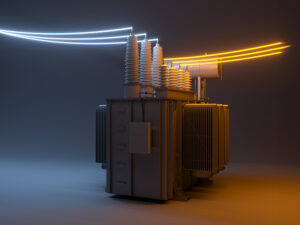 An electrical transformer is an electro-magnetic device that works by converting electrical energy from one value to another.
An electrical transformer is an electro-magnetic device that works by converting electrical energy from one value to another.A transformer has no moving parts and is a completely static solid state device. The primary winding of a transformer is connected to the input voltage supply and transforms the electrical power into a magnetic field. The secondary winding converts this alternating magnetic field into electrical power producing the required output voltage.
Here’s a breakdown of how they work:
- The transformer has coils of wire wrapped around a central iron core.
- An AC current running through one set of coils (primary coil) creates a magnetic field around the core.
- This changing magnetic field then induces a voltage in the other coil (secondary coil).
- The ratio of the number of turns in the primary coil to the number of turns in the secondary coil determines the amount of voltage increase or decrease.
Transformers are crucial for our electrical infrastructure because they allow us to:
- Transmit electricity efficiently over long distances. High voltage transmission lines minimize energy loss over long distances. Then, transformers step down the voltage for safer and more manageable use in homes and businesses.
- Power various devices. Appliances and electronics require different voltage levels to function properly. Transformers adjust the voltage accordingly.
Posted in arizona, circuit, circuit breaker, commercial, contractor, cooling, electric, electrical, electrician, electricity, light, lighting, phoenix, power, safety, wiring